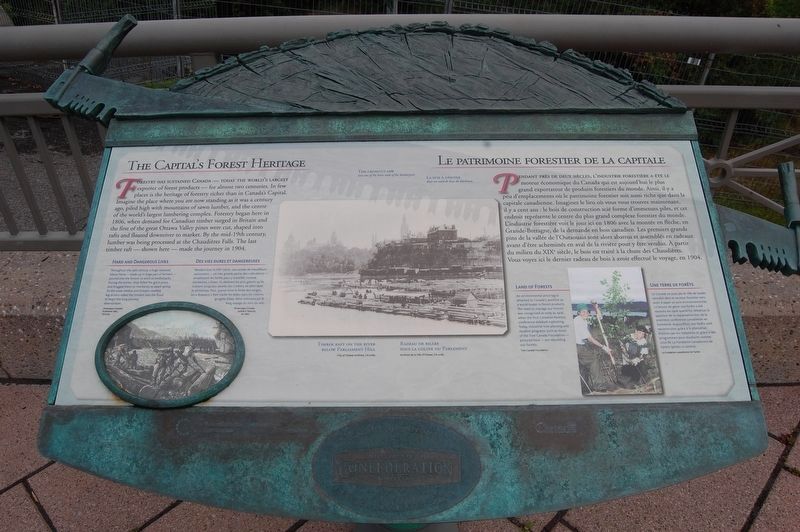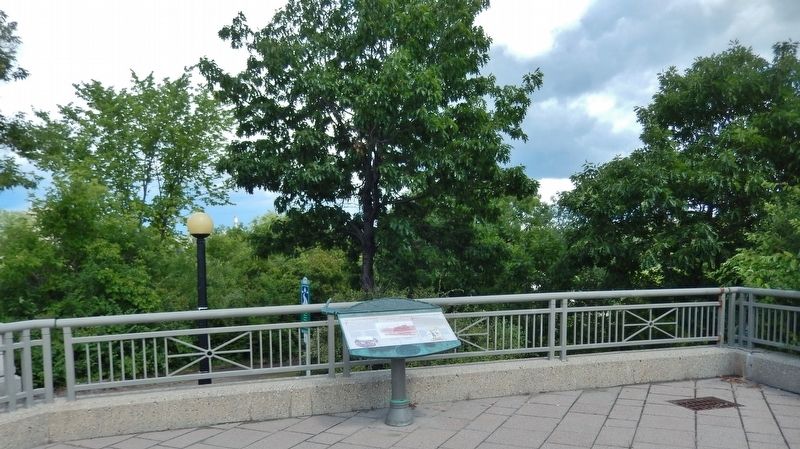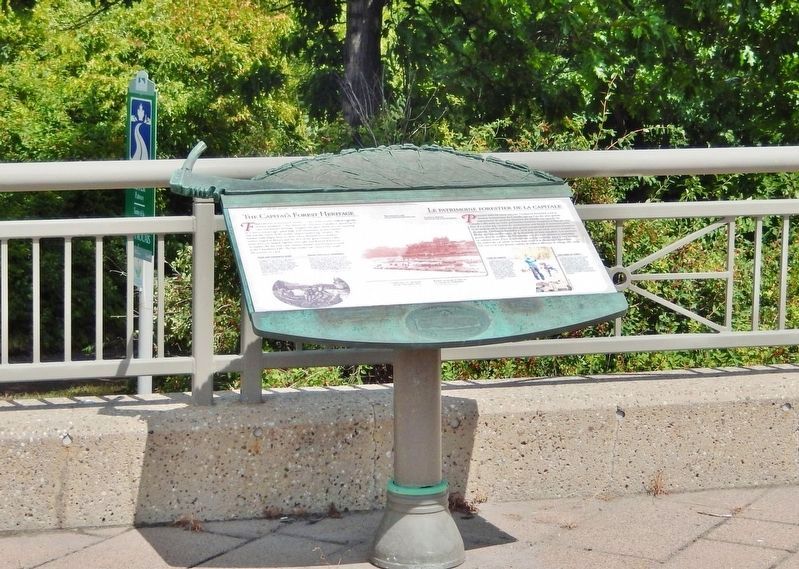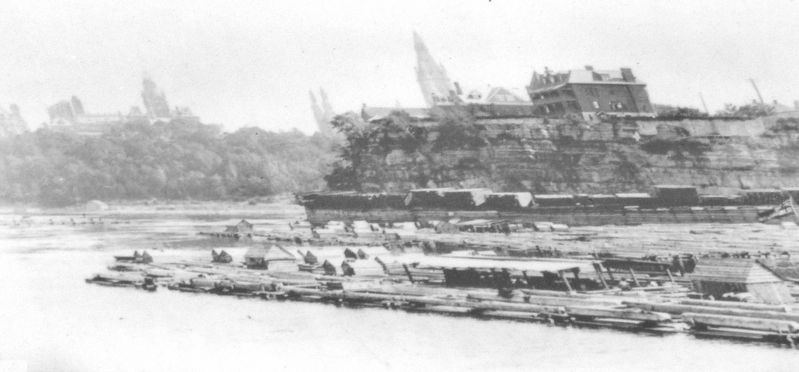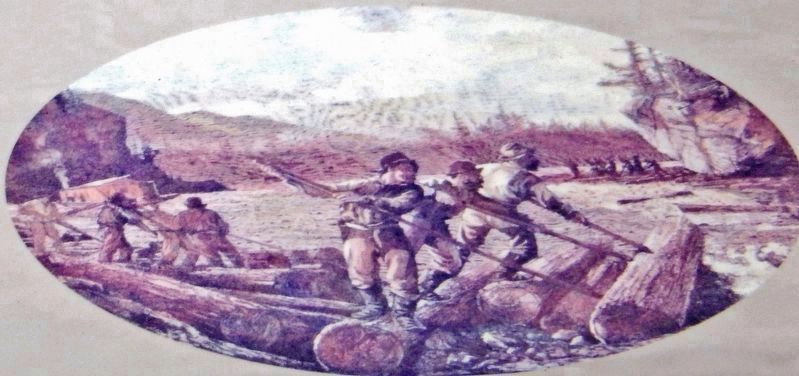Somerset Ward in Ottawa, Ontario — Central Canada (North America)
The Capital's Forest Heritage / Le patrimoine forestier de la capitale
Inscription.
Forestry has sustained Canada — one of the world's largest exporters of forest products — for almost two centuries. Canada’s Capital has its own rich forestry heritage. Imagine the place where you are standing as it was a century ago, piled high with mountains of sawn lumber: this was the centre of the world's largest lumbering complex. The lumber trade began here in 1806, when demand for Canadian timber surged in Britain and the first of the great Ottawa Valley pines were cut, lashed together into rafts and floated downriver to market. By the mid-19th century, lumber was being processed at the Chaudières Falls. The last timber raft (shown here) made the journey in 1904.
Hard and Dangerous Work
Throughout the 19th century, a huge seasonal labor force — made up mainly of farmers — poured into the forests to work as lumberjacks. During the winter, they felled the giant pines and dragged them to riverbanks to await spring. When the ice melted, log drivers rolled the timbers into the flood to begin the long journey downstream.
Land of Forests
Canada’s position as a world leader in forest products comes with an environmental price tag attached. The need to manage our forests was recognized as early as 1906, when the first Canadian forestry conference debated replanting. Today, industrial tree planting and non-profit organizations like Tree Canada are rebuilding our forests.
Pendant près de deux siècles, l’industrie forestière a été le moteur économique du Canada, qui est l’un de plus grands exportateurs de produits forestiers du monde. La capitale du Canada a elle aussi un riche patrimoine forestier. Imaginez le lieu où vous êtes, il y a cent ans : le bois de construction scié forme d’immenses piles, et cet endroit est le centre du plus grand complexe d’exploitation forestière du monde. L’industrie forestière a vu le jour ici en 1806 avec la montée en flèche, en Grande-Bretagne, de la demande en bois canadien. Les premiers grands pins de la vallée de l’Outaouais ont alors été abattus et assemblés en radeaux avant d’être acheminés en aval de la rivière pour y ’être vendus. A milieu du 19e siècle, le bois était traité à la chute des Chaudières. On voit ici le tout dernier radeau de billes à effectuer le voyage, en 1904.
Travail difficile et dangereux
Pendant tout le 19e siècle, une armée de travailleurs saisonniers envahissait les forêts; ces cultivateurs, pour la plupart, y travaillaient comme bûcherons.
L’hiver, ils abattaient les pins géants, qu’ils traînaient jusqu'aux abords des rivières, en attendant le printemps. À la fonte des glaces, les draveurs faisaient rouler les billes jusqu'aux rivières gorgées d'eau. Ainsi commençait le long voyage du bois en aval.
Une terre de forêts
Le secteur forestier du Canada compte parmi les premiers dans le monde, mais ce succès a un prix : son effet sur l’environnement. La nécessité de gérer nos forêts a été reconnue des 1906, quand la première conférence canadienne sur la foresterie s’est penchée sur le reboisement. Aujourd’hui, l’industrie et des organismes sans but lucratif comme Arbres Canada reboisent nos forêts.
Erected by The National Capital Commission / La Commission de la capitale nationale.
Topics. This historical marker is listed in these topic lists: Environment • Horticulture & Forestry • Industry & Commerce • Waterways & Vessels. A significant historical year for this entry is 1806.
Location. 45° 25.194′ N, 75° 42.704′ W. Marker is in Ottawa, Ontario. It is in the Somerset Ward. Marker is on Portage Bridge just north of Wellington Street (Route 34), on the right when traveling north. Marker is located in a walkway plaza near the south end of the Portage Bridge, overlooking the Ottawa River. Touch for map. Marker is in this post office area: Ottawa ON K1A 0N4, Canada. Touch for directions.
Other nearby markers. At least
8 other markers are within walking distance of this marker. Royal Canadian Naval Monument / Monument De La Marine Royale Canadienne (about 150 meters away, measured in a direct line); L’aménagement de la région de la capitale / Building a Capital Region (approx. 0.4 kilometers away in Québec); Christ Church Cathedral / La cathédrale Christ Church (approx. 0.4 kilometers away); Veterans Charter / La Charte des Anciens Combattants (approx. half a kilometer away); The Fleck Fountain / La Fontaine Fleck (approx. half a kilometer away); Canada's Discovery Route / La voie de la découverte du Canada (approx. half a kilometer away in Québec); Le Boulevard de la Confédération / Confederation Boulevard (approx. half a kilometer away in Québec); La Place du Portage / Place du Portage (approx. half a kilometer away in Québec). Touch for a list and map of all markers in Ottawa.
Related markers. Click here for a list of markers that are related to this marker. Confederation Boulevard / Boulevard de la Confédération
Also see . . .
1. Forest History in Eastern Ontario. The beginning of the 19th century saw logging companies hard at work in the Ottawa Valley, and cutting accelerated in the 1800s. White pine was in demand while hardwoods were viewed as mere obstacles in the way of harvesting the pine. In 1845, the upper Ottawa
River watershed was the source of more than 12 million cubic feet of squared pine timber. Eastern Ontario was the source of an additional several million cubic feet. In the mid-1800s, up to 7,000 raftsmen were employed in the lumber trade along the Ottawa River. (Submitted on June 2, 2020, by Cosmos Mariner of Cape Canaveral, Florida.)
2. Tree Canada. Since 1992, we’ve planted more than 82 million trees, greened more than 660 schoolyards, helped restore places hit by natural disasters and brought together urban forestry experts greening cities all across Canada. (Submitted on June 2, 2020, by Cosmos Mariner of Cape Canaveral, Florida.)
Credits. This page was last revised on June 13, 2022. It was originally submitted on May 29, 2020, by Cosmos Mariner of Cape Canaveral, Florida. This page has been viewed 147 times since then and 17 times this year. Photos: 1. submitted on June 1, 2020, by Cosmos Mariner of Cape Canaveral, Florida. 2. submitted on May 31, 2022, by Robert Rusaw of Massena, New York. 3, 4, 5, 6. submitted on June 2, 2020, by Cosmos Mariner of Cape Canaveral, Florida.

